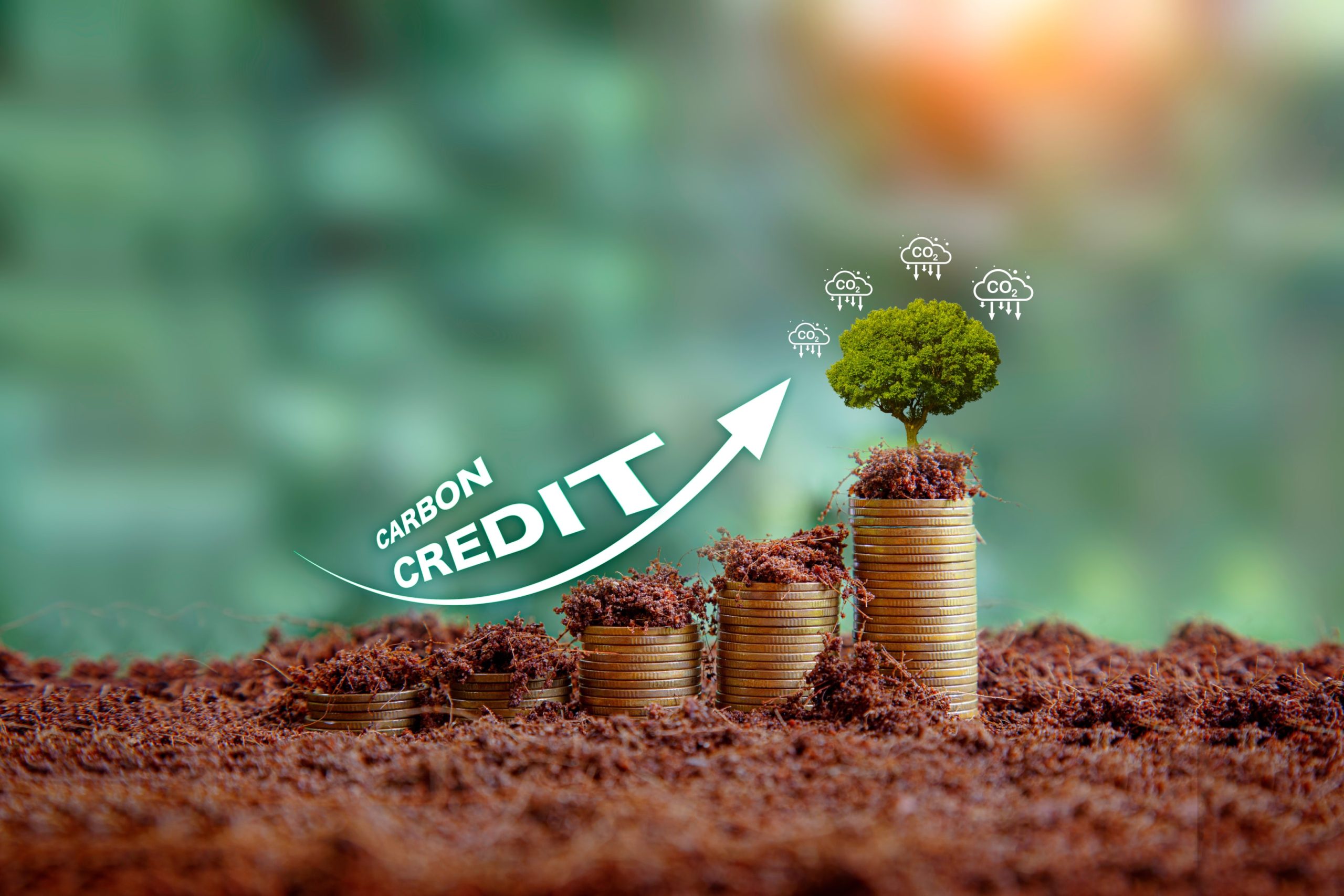What is Carbon Offset?

Carbon offsets are a crucial mechanism for mitigating carbon footprints and contributing to climate goals by buying emissions reductions (carbon credits or carbon finance) to fund projects that reduce carbon emissions. These offsets work by compensating for the emissions produced by an individual or organization through supporting projects that lower emissions elsewhere.
By purchasing carbon credits, businesses and individuals can neutralize their carbon output, effectively balancing their carbon emissions. Carbon offsetting allows businesses to achieve significant climate objectives and supplies essential funding to speed up the global shift towards a low-carbon economy.
How Carbon Offset Reduces Climate Change by Reducing Carbon Dioxide
Carbon offsetting is an essential mechanism for addressing climate change, enabling businesses to address their current carbon emissions while moving towards a more sustainable, low-carbon future.By investing in projects that reduce or capture carbon dioxide, such as reforestation or renewable energy initiatives, businesses can compensate for their emissions.
To keep global warming within the 1.5-degree target established by the Paris Agreement, it is necessary to reduce emissions by half by 2030.This ambitious target underscores the importance of carbon offsetting in the overall strategy to combat climate change.
By supporting projects that sequester carbon or reduce emissions, companies contribute to the global effort to stabilize the climate.
Understanding Your Carbon Footprint

What is a Carbon Footprint?
A carbon footprint represents the total greenhouse gas emissions produced by human activities. It encompasses emissions from various sources such as transportation, energy use, and waste generation.
Understanding your carbon footprint is the first step in reducing your impact on the environment. By identifying the main contributors to your emissions, you can implement strategies to reduce them.
How to Calculate Your Carbon Footprint
Calculate your carbon footprint by measuring your energy consumption, transportation, and waste generation. Various online carbon calculators can help you determine your carbon footprint by inputting data on your daily activities and energy use.
These tools provide a detailed breakdown of your emissions, allowing you to identify areas where you can make the most significant reductions.
Reducing your carbon footprint involves making conscious choices, such as using energy-efficient appliances, reducing car travel, and minimizing waste.
How Carbon Offset Works
Measuring Carbon Emissions
Measure your carbon emissions in tonnes of carbon dioxide equivalent (tCO2e). This measurement includes all greenhouse gases, not just carbon dioxide, adjusted for their global warming potential. Calculating your carbon footprint accurately is crucial for setting a strategy to decarbonize your organization.
By understanding the full scope of your emissions, you can prioritize actions to reduce them. Keywords: measuring carbon emissions, tonnes of carbon dioxide equivalent, tCO2e, global warming potential, decarbonize.
Types of Carbon Offset Projects

Forestry and Conservation
Forestry projects create carbon credits by sequestering carbon through the planting of new trees and by preventing carbon release through the protection of existing forests. High-quality carbon reduction efforts in these large offsets and projects are crucial for sustainability initiatives, ensuring that carbon offset projects not only mitigate carbon emissions but also provide added benefits to local communities and ecosystems.
Companies that offset their carbon emissions for corporate social responsibility (CSR) purposes place significant value on safeguarding ecosystems, wildlife, and social heritage.
Renewable Energy
Renewable energy initiatives facilitate the development and upkeep of solar, wind, and hydro power facilities globally. These investments boost the supply of renewable energy in the power grid, generate jobs, decrease reliance on fossil fuels, and aid in the growth of the renewable energy sector.
These projects are essential for transitioning to a sustainable energy future and mitigating climate change.
Community Projects
Community projects introduce energy-efficient methods or technology to underprivileged communities in developing countries worldwide, emphasizing the importance of energy efficiency in minimizing carbon footprints. The advantages of these projects go beyond generating carbon credits; they enhance regional sustainability and empower communities by fostering independence and self-sufficiency.
Examples include providing clean cooking stoves, installing solar panels, and improving building insulation.
Waste to Energy
Waste-to-energy projects transform waste into usable energy, often by capturing methane and converting it into electricity. Such projects can have a similar positive impact on communities as initiatives focused on clean water or efficient stoves.
By reducing methane emissions from landfills and generating renewable energy, these projects help address both waste management and energy needs.
The Importance of Carbon Offset
Why Reducing Carbon Emissions Matters
Reducing carbon emissions is crucial to combat climate change and its devastating effects on the environment and human societies. High levels of greenhouse gases in the atmosphere lead to global warming, resulting in extreme weather events, sea level rise, and biodiversity loss.
By reducing emissions from fossil fuels, we can mitigate these impacts and protect the planet for future generations.
The Role of Carbon Offset in Combating Climate Change
Carbon offsetting is a crucial tool in combating climate change, enabling individuals and businesses to take responsibility for their carbon emissions and fund projects that reduce greenhouse gas emissions.
By investing in carbon offset projects, they and larger businesses can compensate for their unavoidable emissions and contribute to global efforts to reduce atmospheric carbon levels.
Choosing the Right Carbon Offset Scheme

Certified Carbon Offset Schemes in the UK
The Woodland Carbon Code and the Peatland Code are the only two carbon offsetting schemes accredited by the UK Environmental Agency, highlighting the availability, types, and accreditation of such schemes in the UK.
These schemes ensure that carbon benefits are real, quantifiable, additional, and permanent, providing assurance of the sustainability services their effectiveness.
Evaluating the Effectiveness of Carbon Offset Schemes
Consider the offsetting efficiency of different schemes, from most effective to least effective. Evaluate the scheme’s transparency, additionality, and permanence. Ensuring that the projects deliver genuine and lasting carbon reductions is critical for their credibility and positive impact too.
Popular Carbon Offset Schemes in the UK
Ecologi
Ecologi offers verified carbon offset projects, including tree planting as an additional benefit. They follow the Verified Carbon Standard to ensure transparency and quality in their forest carbon offset and tree planted projects.
By supporting Ecologi, individuals and businesses can trust that their investments are making a real difference.
Climeworks
Climeworks focuses on carbon dioxide removal, employing specialized machines to capture CO2 directly from the air.Their direct air capture technology offers a scalable solution to reducing atmospheric carbon levels.
Carbonfund
Carbonfund is an organization that offers a variety of carbon offset projects and services for businesses. They offer a high degree of flexibility with carbon offsetting schemes tailored to accommodate various business sizes and specific needs.
Other notable schemes
GoClimate, Clear, 3Degrees, NativeEnergy, Sustainable Travel International, TerraPass, Carbon Checkout, Co2nsensus, Reforest’Action and Watershed are other notable carbon offset schemes in the UK. These organizations offer various other carbon reduction plan options for individuals and businesses looking to offset their emissions effectively.
Implementing Carbon Offset
Simple Steps to Offset Your Emissions
Calculate your carbon footprint, reduce your emissions as much as possible, and offset the remaining emissions through a certified, carbon neutral or offset scheme. This approach ensures that your efforts to become carbon neutral are both comprehensive and effective.
Importance of Regular Offsetting for Individuals and Businesses
Regular offsetting is crucial to maintain carbon neutrality and support projects that reduce greenhouse gas emissions. By consistently offsetting their emissions, individuals and businesses can continuously contribute to climate action, carbon neutrality and sustainability.
Carbon Offset for Businesses
Why Businesses Use Carbon Offset
Many small businesses can use carbon offsetting to make a difference to the world and the people in it. Sustainability has become a buzzword, and carbon offsetting is an opportunity for small businesses to grow. By demonstrating their commitment to reducing their carbon footprint, companies can enhance their reputation and meet the expectations of environmentally conscious consumers.
Comprehensive Carbon Offset Programs for Clients
High-quality carbon credits are just one part of a successful carbon offsetting program. Through webinars, briefing papers, and roundtable discussions, businesses can stay up to date with the latest industry and policy developments. These educational resources help companies understand the evolving landscape of carbon offsetting and implement effective strategies.
Frequently Asked Questions
What is Carbon Offsetting?
Carbon offsetting is a process where individuals or businesses compensate for their carbon emissions by investing in projects that reduce or remove an equivalent amount of greenhouse gases from the atmosphere.
These projects can include reforestation, renewable energy installations, and other initiatives that help to balance out the emissions produced by various activities.
How Does Carbon Offsetting Work?
Carbon offsetting works by first calculating the amount of carbon dioxide (CO2) or other greenhouse gases emitted by a specific activity, such as air travel, manufacturing, or energy consumption. Once the emissions are quantified, the equivalent amount of carbon credits is purchased to fund projects that reduce emissions elsewhere.
These projects absorb or avoid CO2, effectively neutralizing the original emissions. The process often involves third-party verification to ensure the legitimacy and impact of the offset projects.
Why Do Businesses Use Carbon Offsetting?
Businesses use carbon offsetting to reduce their environmental impact and demonstrate their commitment to sustainability.
By offsetting their emissions, companies can meet regulatory requirements, improve their corporate social responsibility (CSR) profile, and appeal to environmentally conscious consumers. Additionally, offsetting can help businesses achieve carbon neutrality and support global efforts to mitigate climate change, enhancing their reputation and contributing to long-term sustainability goals.
Addressing Concerns about Carbon Offset
Is carbon offsetting just a way to buy our way out of reducing emissions? Are carbon offset projects effective in reducing greenhouse gas emissions?
Conclusion
Join the Carbon Neutral Britain Movement
Join thousands of individuals and businesses in the carbon neutral UK working together to save the planet. By participating in carbon offsetting initiatives, you can contribute to a collective effort to combat climate change and promote sustainability.
Start Offsetting Your Carbon Emissions Today
Calculate your carbon footprint, reduce your emissions, and offset the remaining emissions through a certified carbon offset scheme. Make a commitment to become carbon neutral in 2024 and be part of the solution to climate change.
